Free Amazon Tools: Complete List
Looking for free Amazon tools to boost your selling strategy without breaking the bank? Whether you’re an Amazon seller or vendor, these free tools for keywords, FBA fees, price tracking, and other essential Amazon metrics can help you optimize your business. In this comprehensive guide, we’ll review the 11 best free Amazon tools currently available, including popular options like CamelCamelCamel, Keepa, and our own AMALYTIX tools.
CamelCamelCamel - Free Amazon Price Tracking Tool
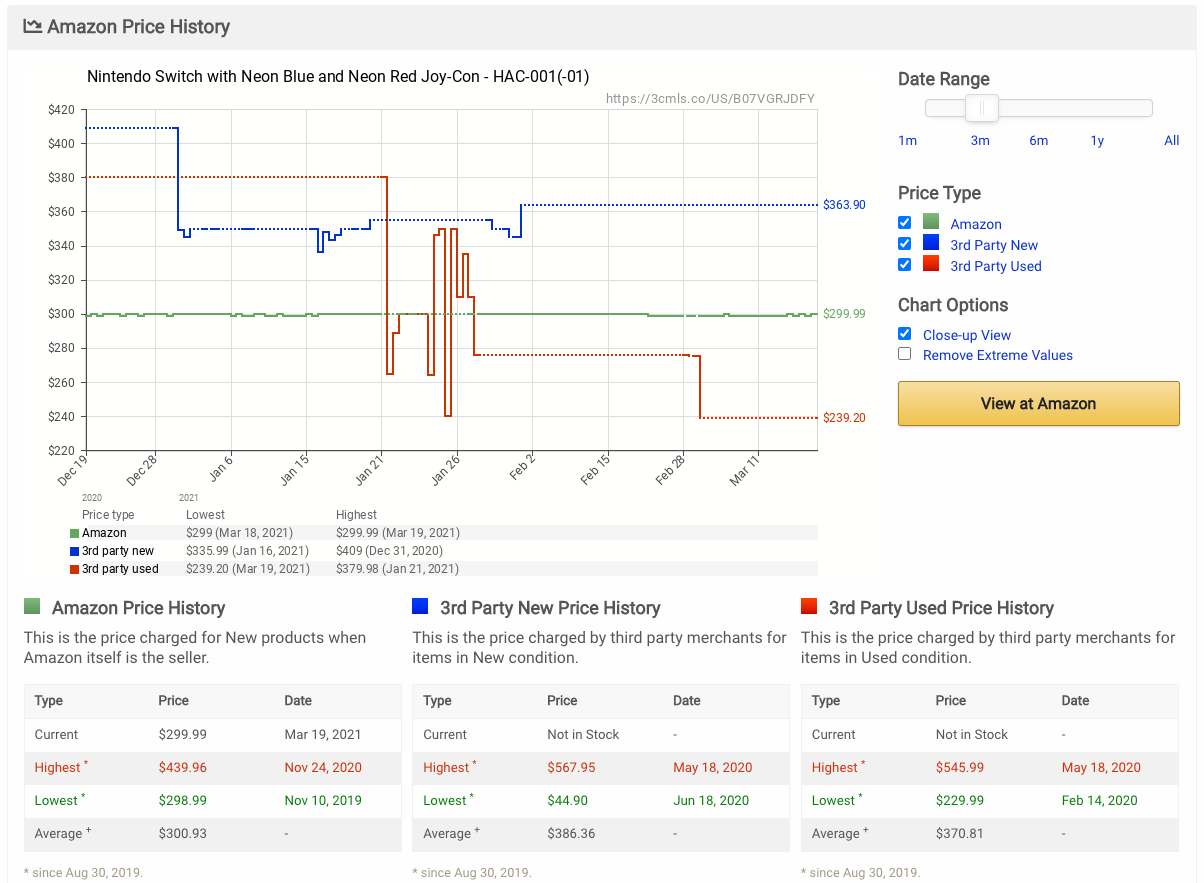
CamelCamelCamel monitors the prices of a variety of products on Amazon. All you have to do is copy the link to the Amazon product you want to monitor into the search bar or search for keywords. Once you have found your desired product, you will be taken to a price overview page. Alternatively, you can also install the browser extension and get directly to the CamelCamelCamel data when you are on a product detail page of Amazon.
You can see not only prices from Amazon (green line), but also from third party New (blue line) and third party Used (red line). Furthermore, CamelCamelCamel additionally shows the Current, Highest, Lowest and Average price for the respective price type in the tables below the graph. The tool can also alert you to price declines.
Currently the tool supports the following marketplaces: Germany, Italy, France, Spain, UK, USA, Canada and Australia.
Use Case
As a vendor or seller, CamelCamelCamel gives you an overview of how the current price of a product should be classified. But also as an Amazon buyer you get an insight into the price development of a product to better assess if you should buy the product at the current price or not.
Costs
The tool can be used for free, but you can also create an account (is not necessary to use the tool).
Link to the tool
Website: CamelCamelCamel
Browser extension: Camelizer
For those who are interested in the technical background of CamelCamelCamel, we recommend this podcast: Podcast with Daniel Green
Keepa - Amazon Price History & Sales Rank Tool

Price developments on Amazon can also be made transparent with Keepa. As with CamelCamelCamel, the page for the respective product must first be opened. This is also done through the search bar, either via a keyword or an Amazon link. After getting to the overview page, the various information that can be displayed within the graph is listed to the right of the graph. This varies depending on the product, depending on what information is available.
Besides the prices of Amazon and Marketplace merchants, Keepa also shows the sales rank (but only in the paid version). As an Amazon Seller/Vendor, you can use this primarily to create a link to the Amazon price, in order to be able to determine what influence which price has on the sales figures with Amazon customers. In addition, the orange-shaded area shows that Amazon had the product in stock at that time. White areas mean that the product was not in stock. However, these are not the only numbers that Keepa provides you with. You can also get BuyBox information, for example. In addition, Keepa offers tighter timeframes for price monitoring, starting as early as one week.
Currently, the tool supports the following marketplaces: Germany, Italy, France, Spain, UK, USA, Canada, India and Japan. According to its own statement, the tool currently monitors about 1.6 billion products.
There is also a browser extension for Keepa:
Keepa Browser Extension from Keepa Tutorials on Vimeo.
In addition, Keepa has its own API: Keepa API This is billed on a usage basis.
Use Case
As a vendor or seller, you can use Keepa to get an overview of how the price of a potentially new product should be classified and also draw conclusions in terms of sales rank. As an Amazon buyer, this tool can be used to find out if you should wait a little longer to buy or not.
Costs
The tool can be used for free, but you have to create an account if you want to view certain data (e.g. the Sales Rank). This then requires a monthly subscription of 15€ per month. Below you can find a comparison table between a free account and a monthly subscription: Click here.
Link to the tool
Keywordtool.io - Free Amazon Keyword Research
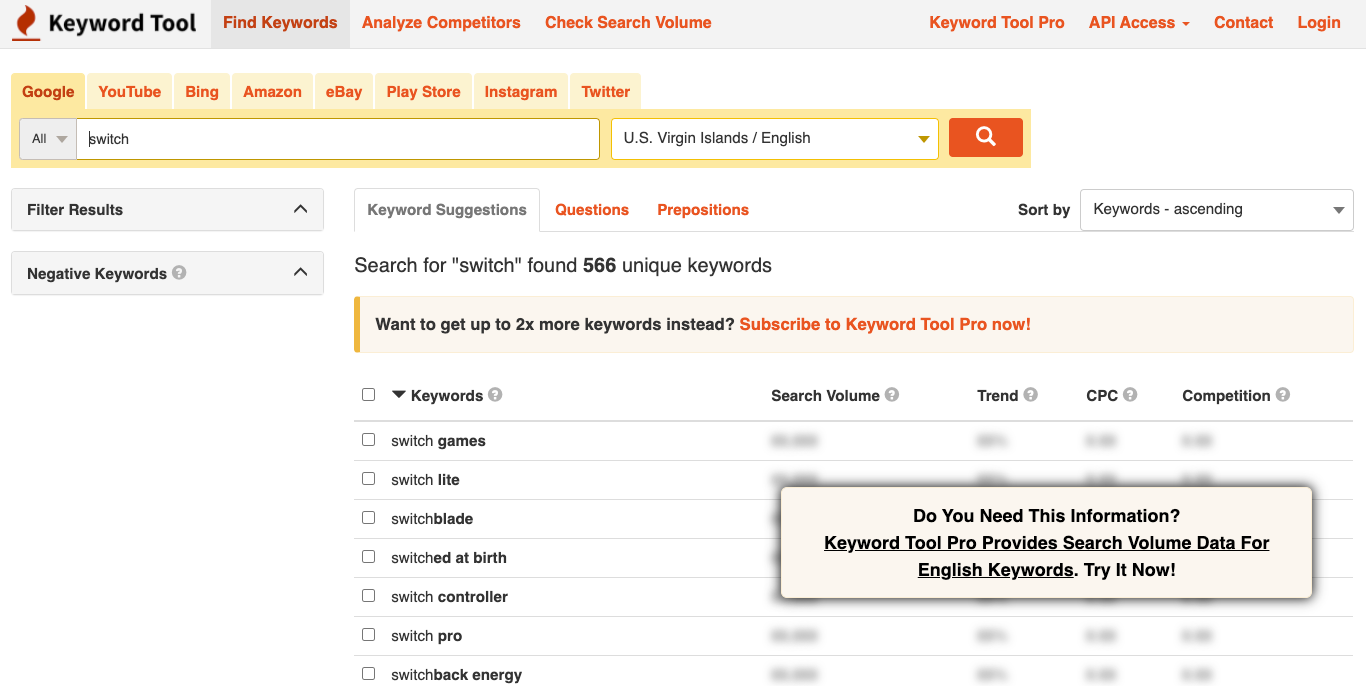
On the Keywordtool.io website, as the name suggests, you can search for keywords. It shows you various keyword combinations and also keyword question combinations that you can use for your keyword research. The keywords themselves are retrieved from Google’s auto-complete. The search volume indicates how many times on average per month people search for that exact keyword. It helps them understand how popular the particular keyword is. Another parameter is the trend, it shows how the monthly search volume for a keyword has changed in the last 12 months. The CPC (cost-per-click) is the estimated amount of money advertisers pay to bid on that keyword in Google Ads. This allows you to see how lucrative the keyword is. The last parameter “Competition” represents the number of advertisers bidding on this keyword, in relation to all keywords in Google. It helps you understand how competitive the keyword is. (70-100 High, 35-69 Medium, 0-34 Low).
Use Case.
The tool is great for keyword research. For example, you can use Keyword.io to find keywords with low competition but high search volume. These keywords are great for SEO and the chance to rank well.
Cost
The tool includes only the keyword view for free. For Keyword.io Pro you have to expect prices from 69$ upwards. A more detailed overview and what you can do with Keyword.io Pro you can find here: Keywordtool.io
Link to the tool
Google Trends - Free Trend Analysis for Amazon Keywords

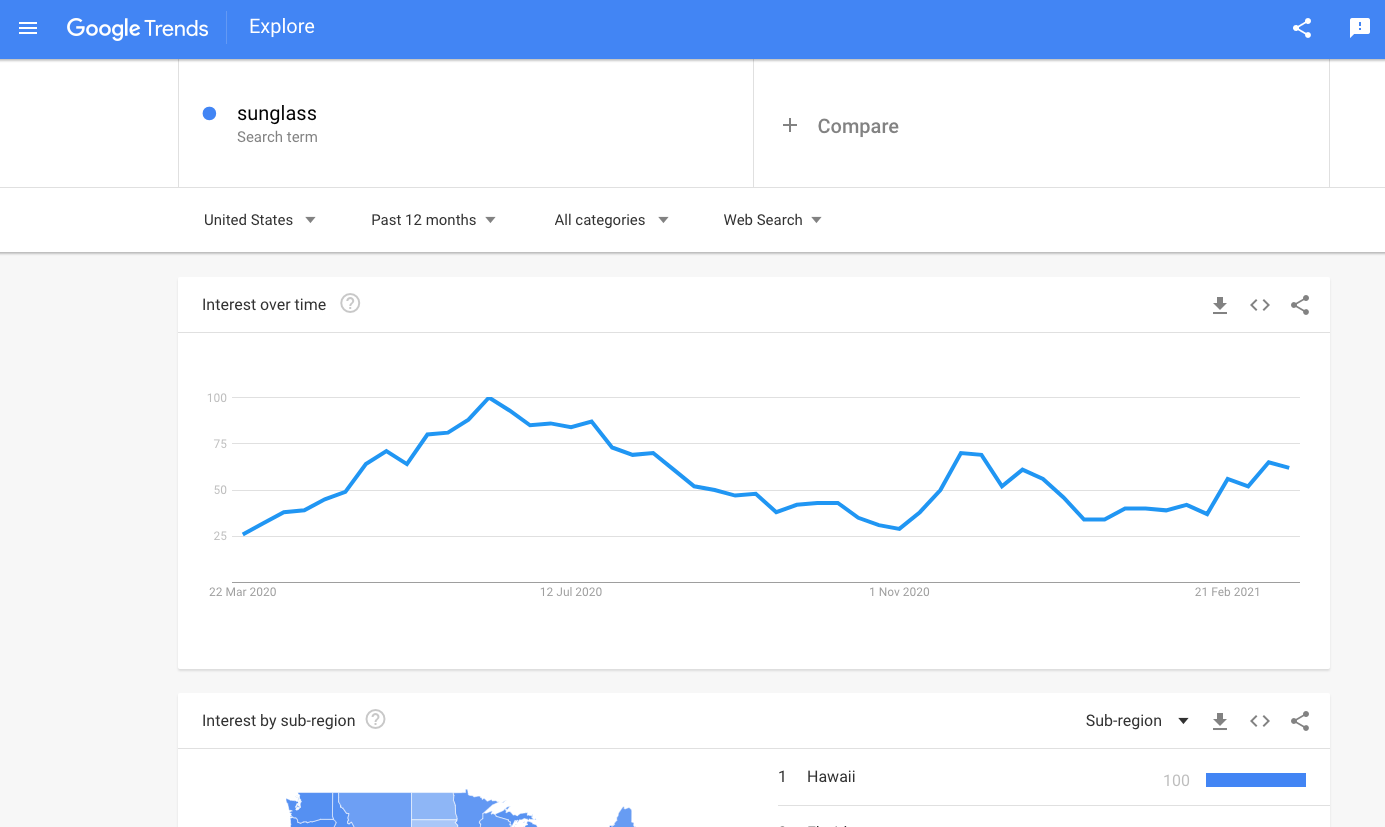
Google Trends shows the relative popularity for a search term or topic over a selected period of time. The relative popularity is the ratio of the search volume of a term to the sum of the search volume of all possible terms. Google Trends excludes repeated searches by the same person over a short period of time in order to provide the user with a better result. With the help of Google Trends, it is possible to query up to five search terms or topics at the same time and compare them. The results are then displayed in a graph, called the Search Volume Index Graph. The data from the graph can also be exported in a CSV file. In addition, the results can be sorted by country, city and time period.
Use Case
With Google Trends, you can see when which keywords are generating increased interest among the population. For example, you can enter different keywords at different times of the year (see Figure 5 with search term sunglasses).
Example: Comparison of “mouth-nose protection” and FFP2 in Germany last 12 months: Google Trends example.
Costs.
The tool can be used free of charge.
Link to the tool
AMZ Base - Free Amazon Product Research Tool

The Browser Extension of AMZ Base supports you in searching for products for sale on Amazon. With the Browser Extension you can quickly read out the ASIN-No. and the title descriptions on Amazon. It also provides instant access to CamelCamelCamel, Alibaba, AliExpress, eBay and Google search engines. At the same time, it calculates FBA fees to estimate your potential profits. For the latter, you either need a US Seller account or you can click on as a guest. With the so-called Amazon Revenue Calculator, you can specify your fulfillment costs and make real-time cost comparisons between your fulfillment and AMZBase’ offer for customer orders fulfilled on Amazon.com.
Use Case
Seller and Vendors can use this tool to help them research new product ideas. By connecting to Alibaba or Aliexpress, you can directly locate possible suppliers.
Costs
The tool can be used free of charge.
Link to the tool
AMALYTIX Amazon Short-Tail Keyword Research Tool
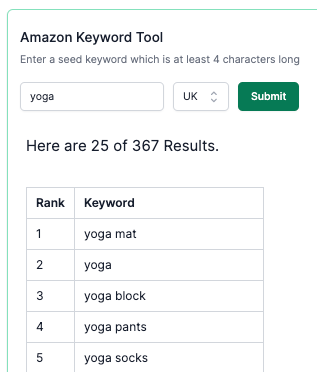
The AMALYTIX Keyword Tool is suitable to find out much searched short-tail keywords for a search term. A large number of searches take place on Amazon every day. For listing optimization, it is interesting whether searches are more frequently made for search term A or for search term B. Find out with the AMALYTIX Short-Tail Keyword Reseach Tool in which order the keywords are searched, i.e. a keyword with rank 2 is searched more often than a keyword with rank 3. This tool complements other keyword research strategies and helps you optimize your Amazon content.
Use Case
For example, if you want to sell yoga accessories, you should rather use the search term “yoga mat” or “yoga mat” in the title. Optimize your keywords with this tool and land better rankings.
Costs
The tool can be used free of charge.
Link to the tool
AMALYTIX Amazon EAN/GTIN Barcode Generator Tool

In order to sell items on Amazon, you generally need a unique “GTIN” (Global Trade Item Number) for each item. The exceptions to the exemption from this principle on the part of Amazon can be found here. The GTIN used to also be called “EAN”, but this term is considered obsolete.
In Germany, the GTINs are managed by GS1. The GS1 offers different packages, which differ in the size of the number range. You can currently license 100 (unofficial small package), 1,000, 10,000 or 100,000 numbers there. However, GS1 does not send you a complete overview of all licensed numbers, but only your “Global Location Number” (GLN). Using the GLN, a sequential number and a check digit, you then have to assemble your own 13-digit GTIN yourself.
This tool does this calculation for you and also directly generates matching barcodes in EAN-13 format if you wish. All you have to do is enter your GLN in the field below and click on “Submit”. For 7-digit GLNs it may take a few seconds until all GTINs are displayed. Clicking on the GTIN will open the EAN-13 barcode in a new window.
Use Case
As a seller, you can use this tool to quickly create the barcodes you need for your business. In addition, the tool will create all possible GTINs for you based on your GLN.
Cost
The tool can be used for free.
Link to the tool
AMALYTIX Amazon Title Checker Tool

A good Amazon product title can significantly influence the sales of a product. Since more and more customers are buying on mobile devices, it should be checked beforehand whether the title can also be displayed correctly on mobile devices. With the AMALYTIX Title Checker you can optimize your product title live. The following parameters are continuously displayed: The number of characters, the length in pixels and whether a forbidden character or word was used or not.
Use Case
As an Amazon Seller or Amazon Vendor, test your headlines before you submit them to Amazon and rank lower because of it.
Cost
The tool can be used for free.
Link to the tool
Sonar - Free Amazon Keyword Tool by Sellics

The Amazon keyword research tool Sonar is a constantly self-updating database of Amazon product and keyword combinations. Using Sonar, statements can be made about the keyword search volume. Amazon itself does not provide data on keyword search volume. Sonar therefore uses a prediction algorithm that calculates the probability of keyword occurrence. In addition, Sonar is available internationally for Amazon USA and Amazon EU, DE, UK, FR, ES, IT. In addition to keywords, it is also possible to simply enter an ASIN in Sonar, the tool then uses this to determine and track competitors’ keywords. The data from the graph can also be exported in a CSV file.
Use Case
Sonar helps you, as an Amazon Seller/Vendor/Agency, to find relevant keywords for your business and thus increase the visibility of your product display and thus improve your Amazon SEO.
Costs
The tool can be used for free.
Link to the tool
ReviewMeta - Free Amazon Review Analysis Tool
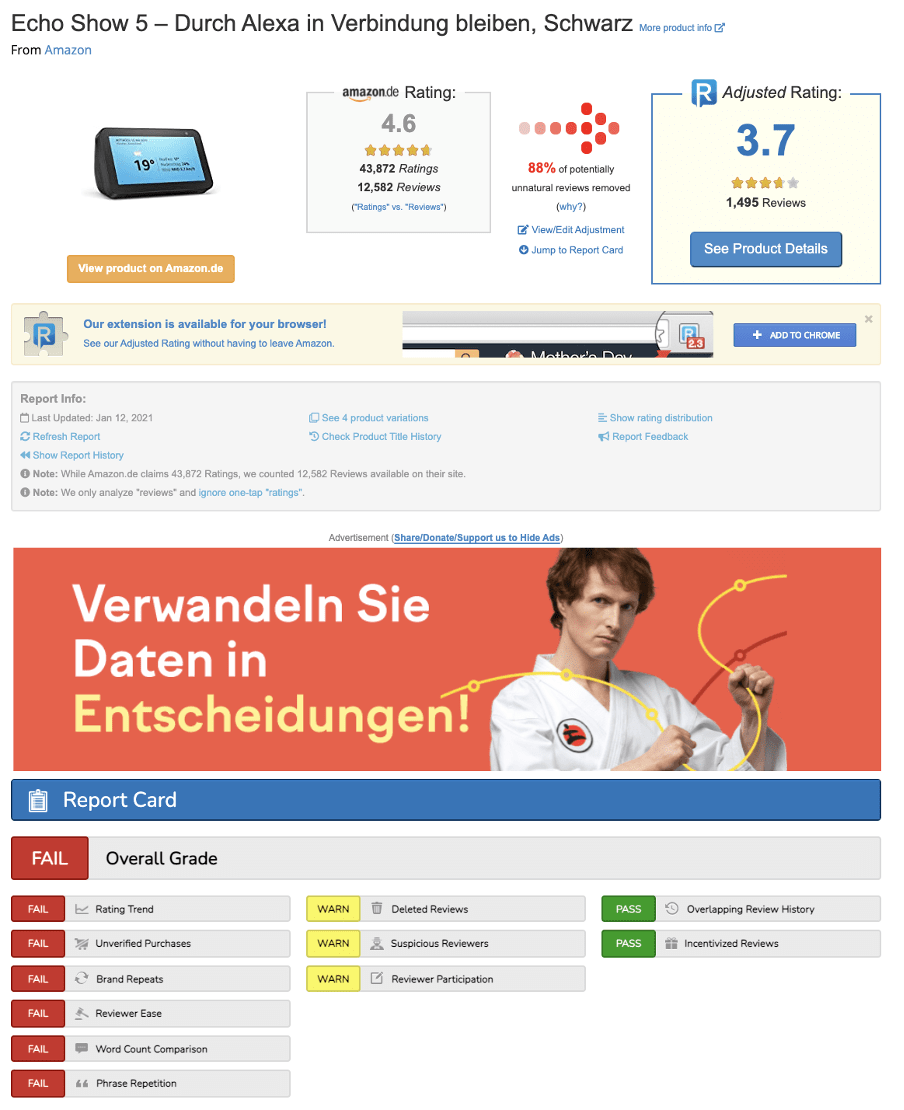
Review Meta is a tool for reviews on Amazon. It analyzes the product reviews of a product on Amazon and filters out reviews that could potentially be unnatural. After entering a link to an Amazon product, Review Meta creates a full page of review analysis. After the calculation, Review Meta displays how many reviews it believes are genuine. In addition, Review Meta filters out comments from product testers. After the webapp has filtered out some reviews, it also calculates the “Adjusted Rating”. In the example above, out of 4.6 stars, only 3.7 stars remain after Review Meta has gone through the reviews.
Use Case
Review Meta helps Amazon buyers uncover fake reviews and gussied up products. It can also be helpful for Amazon Sellers and Amazon Vendors to find out if there are fake reviews on their own products.
Costs
The tool can be used for free.
Link to the tool
Summary
These free Amazon tools provide essential functionality for sellers and vendors looking to optimize their Amazon business without significant upfront investment. From price tracking with CamelCamelCamel and Keepa to keyword research with our AMALYTIX tools, each tool serves a specific purpose in your Amazon strategy. For more advanced strategies, check out our guides on e.g. analyzing Amazon reviews with AI.
Subscribe to Newsletter
Get the latest Amazon tips and updates delivered to your inbox.
Wir respektieren Ihre Privatsphäre. Jederzeit abbestellbar.
Related Articles
AMALYTIX Alternatives - Which is the Best Amazon Tool?
We compare the best Amazon tools for sellers and vendors.

Trutz Fries